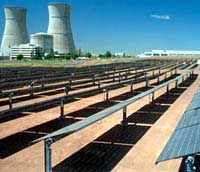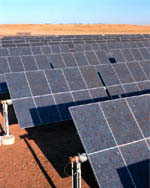This essay is adapted from The Official Earth Day Guide to Planet Repair.

The environmental movement has displayed remarkable strength since the first Earth Day in 1970. It has battled heroically to safeguard the world’s health, diversity, and beauty, and it has been astonishingly successful. However, as the Earth’s odometer rolls over into a new century, the Earth is facing a new threat — global warming — that dwarfs earlier perils.
Each one of us can do a number of common-sense things to help combat global warming by reducing dramatically the greenhouse gas emissions from our homes, cars, businesses, schools, and so forth. Still, personal choices are not a substitute for political action. Ultimately, global problems can only be solved through public policies. To tackle global warming, we need to mobilize for a political struggle to change policies governing energy — and we can start with a shift that would give a big boost to solar power.
Buy and Large
One of the most valuable things that government can do in the early stages of a product’s development is to buy it in volume. In field after field, large-scale government procurement has brought down the cost of items as diverse as jet planes, drugs, and computers to the point where the private market could take advantage of them.
The government should play a similar role in propelling the energy revolution. Large public-sector commitments to buy wind turbines, biofuels, fuel cells, hydrogen, hypercars, and other elements of a solar future will accelerate the speed at which such products become affordable for the rest of us. We typically think in terms of federal procurement, but state and local governments can play an important role too.
There is no more obvious a candidate for a federal buy-down than solar cells. Lowering the cost of solar cells would provide extraordinary public benefits. Solar cells make electricity, but they consume no fuel, produce no pollution, generate no radioactive waste, have long lifetimes, contain no moving parts, and require little maintenance. They can be fashioned mostly from silicon, which is the second most abundant element in the Earth’s crust. Solar cells produce zero carbon dioxide, the chief greenhouse gas.
Unfortunately, solar cells are not yet cheap enough to compete with heavily subsidized fossil fuels. Although the price of solar cells already has fallen about 40-fold, this technology remains roughly three times too expensive to achieve skyrocketing growth as a power source in the United States.
For a quarter-century, affordable solar cells have been the environmental brass ring, lying just outside the grasp of those who favor green power. Governmental procurement could lower their price to the point where they will take off on their own in the private sector. A comparison of the experiences of computer chips and solar cells vividly illustrates the value of government procurement in bringing new products to market.
Throwing a Curve
New technologies follow predictable learning curves. As production volumes increase, costs fall. For example, a product with an 80-percent learning curve will experience a 20-percent price drop when the volume is doubled. If production is doubled again, the price will decline an additional 20 percent.

Out with the old, in with the new.
Photo: NREL/PIX.
This is common sense. If I gave you a pile of raw materials and said, make me a car, it would cost a fortune (and it probably would not be a very good car). If car-making grows into a cottage industry, prices will fall — perhaps into the range of a hand-built Ferrari. When volumes swell and you are manufacturing tens of thousands of cars per year, the marginal cost of making one more car will be very low.
Solar cells are currently at the cottage industry scale. A single nuclear power plant produces 25 times as much electricity in a year as will all the solar cells sold in the entire world last year. Of course solar cells remain expensive!
Until the solar-cell industry can leap to the next stage — mass production — all the investments the public has made in research and engineering will be left dangling.
When the Chips Were Down
The solar industry should learn from the experience of the electronics industry. Consider, for example, the history of the integrated circuit. In 1961, Texas Instruments began producing integrated circuits for small, specialized applications. The earliest versions were very expensive. They cost $100 but replaced just a couple dollars’ worth of larger electronics, perhaps two transistors and three resistors. There was essentially no market for such devices in the private sector. Other electronics companies sneered at them.
But the American military recognized the potential importance of small, lightweight, low-power integrated circuits. The Department of Defense began to purchase integrated circuits in large quantities. Following a learning curve, the price fell dramatically. As the price fell, numerous private market niches opened up. Soon, the cost of integrated circuits fell to the point where private markets developed explosively. In just six years, the price of integrated circuits plummeted 95 percent and an enormous commercial market developed.
In 1971, Intel introduced the first central processing unit (CPU). The early CPUs were not immediately transformational. They were too simple to power anything beyond a calculator. However, those calculations rapidly became more and more sophisticated. By the mid-1970s, microprocessors were performing computations for small computers.
Continuing price drops could then be driven by private demand. The processing power of CPUs has continued to double every 18 months (as famously predicted by the chairman emeritus of Intel, Gordon Moore). Accompanied by falling costs, this led directly to the information revolution.
Integrated circuits are now dirt cheap and CPUs are ubiquitous in our homes, cars, and workplaces. But if the government had not purchased huge quantities of chips before they were cheap enough for commercial applications, the technology might never have become cost-effective. The information revolution would have been delayed, perhaps indefinitely.
Cost Cutting
The same basic economic approach would work for solar cells (which, coincidentally, are made of the same semiconductor materials as computer chips). Every time the volume of solar cells has increased in the past, the cost has fallen. Convincing evidence shows that this learning curve will continue as it has with computer chips. The consumer market already is there, just waiting for the price of solar cells to drop. Every poll ever conducted on the issue concludes that most Americans would prefer to get their energy from the sun, if only they could afford to.

Sunshine on my solar cell makes
me happy.
Photo: NREL/PIX.
Put simply, a n
ational program to spend $5 billion over the next four years could make solar cells commercially viable for a significant portion of all new electrical generation worldwide. An announcement that the government will buy $1 billion worth of solar cells in 2001 at an inflation-indexed price of $3.50/watt; $1 billion worth in 2002 at $2.50/watt; $1 billion worth in 2003 at $1.50/watt; and $2 billion worth in 2004 at $1.00/watt would catapult America back into the global lead in solar energy. (If the new president makes it a priority, the entire program could be completed in his first term.)
The economic consequences of a program designed to reduce the price of solar cells would all be positive. Such an initiative would open a large, new global market for American technology and create a rich new source of American jobs.
When the price of a product is lowered due to bulk orders from the government, the change is permanent. Unlike, say, taxes and tax credits, economies of mass production cannot be repealed. Part of the beauty of this approach is that, after just a few years, as with computer chips, no additional government subsidy is required.
The program is risk-free. If no company steps forward to sell the equipment at those prices, the program will not cost a cent. But if some companies are able and willing to meet the challenge, the impact on the world will be revolutionary.



